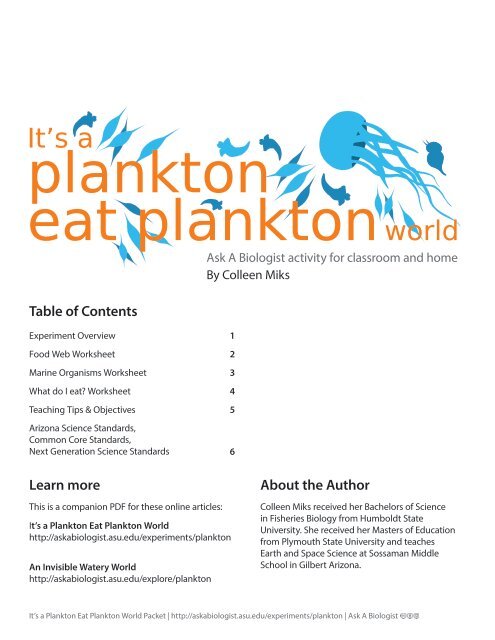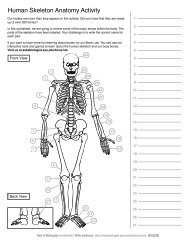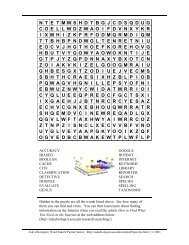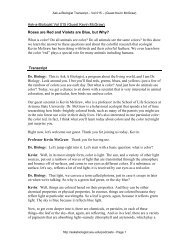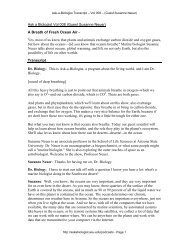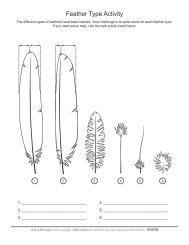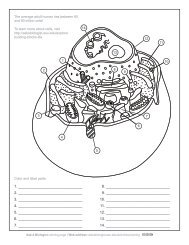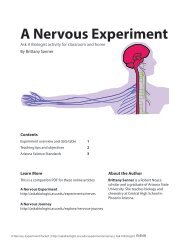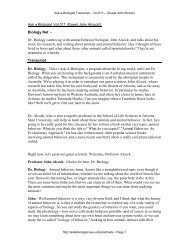Download PDF - Ask A Biologist
Download PDF - Ask A Biologist
Download PDF - Ask A Biologist
- No tags were found...
Create successful ePaper yourself
Turn your PDF publications into a flip-book with our unique Google optimized e-Paper software.
It’s aplanktoneat plankton worldTable of Contents<strong>Ask</strong> A <strong>Biologist</strong> activity for classroom and homeBy Colleen MiksExperiment OverviewFood Web WorksheetMarine Organisms WorksheetWhat do I eat? WorksheetTeaching Tips & ObjectivesArizona Science Standards,Common Core Standards,Next Generation Science Standards123456Learn moreThis is a companion <strong>PDF</strong> for these online articles:It’s a Plankton Eat Plankton Worldhttp://askabiologist.asu.edu/experiments/planktonAn Invisible Watery Worldhttp://askabiologist.asu.edu/explore/planktonAbout the AuthorColleen Miks received her Bachelors of Sciencein Fisheries Biology from Humboldt StateUniversity. She received her Masters of Educationfrom Plymouth State University and teachesEarth and Space Science at Sossaman MiddleSchool in Gilbert Arizona.It’s a Plankton Eat Plankton World Packet | http://askabiologist.asu.edu/experiments/plankton | <strong>Ask</strong> A <strong>Biologist</strong>
Experiment OverviewInside a drop of water that you might collect from a stream, river, lake or ocean are tinyorganisms. These tiny and sometimes not so small living things are called plankton.What role do plankton play in aquatic food webs? What do plankton eat, and what usesplankton as a food source? As you learned in Invisible Watery World, there are two differenttypes of plankton, phytoplankton and zooplankton.All other life in the ocean needs phytoplankton to survive. Phytoplankton get their energy directly from thesun using photosynthesis, just like plants. Zooplankton then feed on phytoplankton, and are then eaten bylarger zooplankton, fish, larger fish, and so on. Plankton are at the base of a complex aquatic food web.During this activity you will learn how to create your own food web. You will also analyze the feedingrelationships between marine organisms and describe plankton’s importance to the ecosystem.What you need• Marine Food Web worksheets• Colored Pencils• Scissors• Yarn• GlueBefore you begin• Print out the Marine Food Web worksheets (pages 3-5).• Color and cut out the marine organisms on the “Marine Organisms” page.• Read “Invisible Watery World” and look at the “What do I eat?” table.ProcedureStep 1: You will use the yarn to show how organisms are connected in your foodweb. Start with the phytoplankton that you colored and cut out. You will gluethe phytoplankton to your “Marine Food Web” worksheet. The sun providesphytoplankton the energy needed to survive. Represent the relationshipbetween the sun and phytoplankton with a piece of string.Step 2: Draw an arrow to show the direction the energy moves. Arrows representenergy flow from one organism to the next so make sure that your arrow facesthe right direction. The sun gives energy to phytoplankton, so the arrow facesphytoplankton, as shown in the figure.Energy flowPhytoplanktonEnergy flowZooplanktonStep 3: Which organisms consume phytoplankton to gain energy for survival? Zooplankton. Just like in steps1 and 2, you will represent this relationship by connecting the phytoplankton and zooplankton with a pieceof string, and draw an arrow to show the energy flow. Make sure your arrow is pointing in the right direction.Step 4: Keep adding organisms, using the “What do I eat?” table to figure out what each organism eats. Addorganisms until you reach one that is not consumed by any other organism. That organism is called an ApexPredator.Step 5: You will have some cut-out organisms that are not part of your food web. That’s okay! Start againwith the sun and add on each organism just like you did before. Keep adding arrows to show which way theenergy flows. When you run out of organisms, you are done.The end result will be a Marine Food Web!It’s a Plankton Eat Plankton World Packet | http://askabiologist.asu.edu/experiments/plankton | <strong>Ask</strong> A <strong>Biologist</strong> 2
Marine Food WebIt’s a Plankton Eat Plankton World Worksheet | http://askabiologist.asu.edu/experiments/plankton | <strong>Ask</strong> A <strong>Biologist</strong> 3
Marine Organisms163512119210478It’s a Plankton Eat Plankton World Worksheet | http://askabiologist.asu.edu/experiments/plankton | <strong>Ask</strong> A <strong>Biologist</strong> 4
# Name What do I eat?1PhytoplanktonI use energy from sunlight to turn carbon dioxide gas into sugars.2ZooplanktonI eat phytoplankton.3Small fishI eat zooplankton.4ShellfishI eat zooplankton.5JellyfishI eat small fish and zooplankton.6Sea turtleI eat jellyfish and small fish.7Large fishI eat small fish.8Sea LionI eat small fish.9Sea BirdI eat small fish, jellyfish, and shellfish.10SharkI eat small fish, large fish, and sea lions.11Toothed whaleI eat small fish, large fish, and sea lions12Baleen whaleI eat zooplankton.It’s a Plankton Eat Plankton World Worksheet | http://askabiologist.asu.edu/experiments/plankton | <strong>Ask</strong> A <strong>Biologist</strong> 5
For TeachersThis activity is a great way to show students how complex food webs are.Tips for Classroom ImplementationTime Required: 50 minutesClassroom set-up: Supply each student or pair of students with the three worksheets (“Marine Food Web”,“Marine Organisms”, and “What do I eat?”) in this <strong>PDF</strong>. Supply markers, scissors, yarn, and glue.Tips• This activity can be done independently but I have found it works best in pairs.• Read “Invisible Watery World” as a class before beginning this activity. It gives students backgroundinformation about how plankton fit into the food web.• This is a great activity to do after a lesson on feeding relationships. It allows students to use theinformation they just received to build a food web showing the feeding relationships found in an aquaticecosystem.Extensions• Have students answer the following questions using their completed marine food web.1. What would happen to your food web if the phytoplankton died out because of water pollution?2. How would the jellyfish population be affected if sea turtles were removed?3. How important are plankton in the marine food web? Explain your answer using evidence from yourfood web.4. Why do we use arrows when creating a food web? What do they represent?5. Using the food chain below, summarize the flow of energy from organism to organism.6. Sun Phytoplankton Zooplankton Small fish Jellyfish Sea Turtle• Create a food web using the organisms found in a sample of pond water (requires microscope).• Create a food web using different biomes (rain forest, desert, grasslands).Objectives1. Students will identify the relationships among organisms within and aquatic ecosystem2. Students will diagram the energy flow in an ecosystem through a food chain.It’s a Plankton Eat Plankton World Packet | http://askabiologist.asu.edu/experiments/plankton | <strong>Ask</strong> A <strong>Biologist</strong> 6
StandardsArizona Science StandardsStrand 4: Life ScienceConcept 3: Populations of Organisms in EcosystemsGrade 6Grade 7PO 1. Explain that sunlight is the major source of energy for most ecosystems.PO 1. Compare food chains in a specified ecosystem and their corresponding food web.PO 3. Analyze the interactions of living organisms with their ecosystems.PO 6. Create a model of the interactions of living organisms within an ecosystem.Grades 9-12PO 1. Identify the relationships among organisms within populations, communities,ecosystems, and biomes.Concept 5: Matter, Energy, and Organization in Living SystemsGrades 9-12PO 4. Diagram the energy flow in an ecosystem through a food chain.Common Core Standards6-8.RST.4. Determine the meaning of symbols, key terms, and other domain-specific words and phrases asthey are used in a specific scientific or technical context relevant to grades 6–8 texts and topics.• Read about food chains and food webs, and then identify the linguistic roots and affixes to help themidentify the meanings of terms related to trophic levels, such as carnivore, herbivore, omnivore, autotroph,and heterotrophy. (SC07-S4C3-01)• Determine the meaning of the direction of the arrows in the food chains and food webs. (SC07-S4C3-01)6-8.RST.7. Integrate quantitative or technical information expressed in words in a text with a version of thatinformation expressed visually (e.g., in a flowchart, diagram, model, graph, or table).• Integrate written descriptions of a Marine food web with visual representations of the Marine food webNext Generation Science StandardsMS-LS1-6.• Construct a scientific explanation based on evidence for the role of photosynthesis in the cycling ofmatter and flow of energy into and out of organisms.It’s a Plankton Eat Plankton World Packet | http://askabiologist.asu.edu/experiments/plankton | <strong>Ask</strong> A <strong>Biologist</strong> 7


